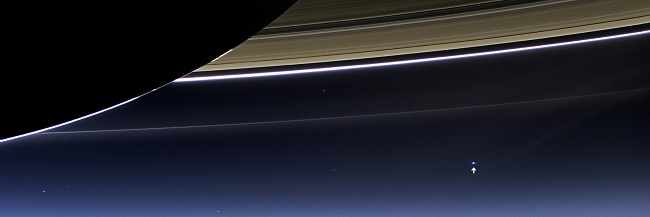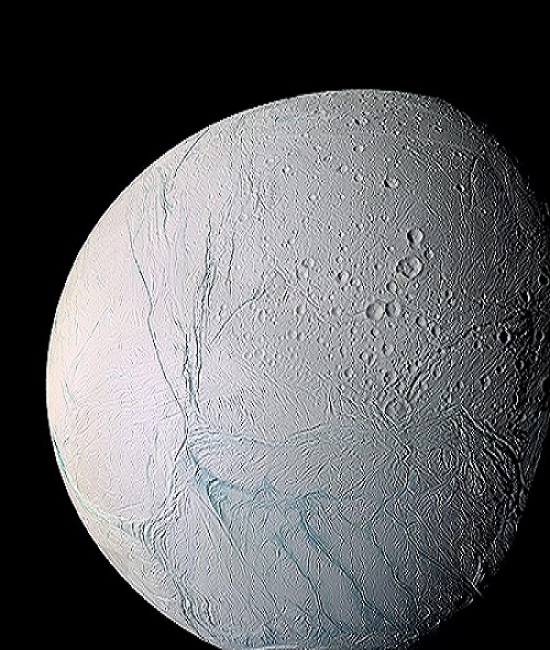Saturn’s Icy Moon’s Eruptions Explained
 NASA/JPL-Caltech/Space Science Institute, Public domain, via Wikimedia Commons
NASA/JPL-Caltech/Space Science Institute, Public domain, via Wikimedia Commons
Thanks to the Cassini spacecraft, Saturn’s moon Enceladus has been being monitored since 2005. And what it has discovered has given scientists a reason to dig deeper into why this icy moon has sustained eruptions.
Scientists at the University of Chicago and Princeton University have pinpointed a mechanism by which cyclical tidal stresses are occurring with Enceladus’ long-lived eruptions.
Edwin Kite from the University of Chicago made this statement;
“On Earth, eruptions don’t tend to continue for long. When you do see eruptions that continue for a long time, they’ll be localized into a few pipe-like eruptions with wide spacing between them.”

NASA/JPL/Space Science Institute, Public domain, via Wikimedia Commons
Enhanced color view of Enceladus showing much of the southern hemisphere and includes the south polar terrain at the bottom of the image. Photo Credit; NASA/JPL/Space Science InstituteResearchers on this project theorize that Enceladus probably has an ocean underlying its icy surface, which manages to sprout multiple fissures along its south pole. These fondly named “tiger stripes” appear to have been continuously emitting tiny frost particles and vapor along their entire length for more than decades.
“It’s a puzzle to explain why the fissure system doesn’t clog up with its own frost,” Kite said. “And it’s a puzzle to explain why the energy removed from the water table by evaporative-cooling doesn’t just ice things over.”
So where is the energy source coming from to balance out this evaporative-cooling? Kire states;
“We think the energy source is a new mechanism of tidal dissipation that had not been previously considered.”
Another researcher, Carolyn Porco, head of Cassini’s imaging science team and a leading scientist in the study of Enceladus states;
“I was very happy to see this new work by Kite and Allan Rubin from Princeton University, New Jersey, that brings to the fore a process that had escaped notice: the pumping of water in and out of the deep fractures of the south polar ice shell by tidal action.”
The Eruptions
Experts agree that Enceladus may be the best candidate for extraterrestrial life and as Kite sites, “an opportunity for the best astrobiology experiment in the solar system.”
Data from Cassini has strongly noted that these cryovolcanic plumes coming out of the icy moon have most likely originated in a biomolecule-friendly oceanic environment. In addition, these recent findings are also being linked the shaping of Europa’s (one of Jupiter’s moons) as well.
“Europa’s surface has many similarities to Enceladus’ surface”
However, one piece of the puzzle is still eluding researchers. The eruptions are reaching their peaks about five hours later than expected. Some scientists theorize the lag may be due a natural delay as well a “squishy,” slowly responding ice shell. But Porco refuted saying;
“The new proposal is really a way to get a delay in the eruptions. You really don’t need to propose any terribly squishy ice shell to do it.”
Other questions plaguing researchers is why does Enceladus maintain a base level of cryovolcanic activity, even when they should clamp shut and curtail the eruptions? Why does the volcanic system generate five gigawatts of power instead of a lot more or a lot less? Why don’t the eruptions frost over or freeze over?
The Model
The Kite-Rubin model of the Enceladus plumbing system consists of a series of nearly parallel, vertical slots that reach from the surface down to the water below. Kite and Porco then applied Saturn’s tidal stresses to their model on a desktop computer and watched what happened. But there was a tricky part.
“The only tricky part quantitatively is calculating the elastic interactions between the different slots and the varying water level within each slot as a response to the tidal stress,” Kite explained.
With wide slots, the eruptions respond quickly to tidal forcing, while the narrow slot eruptions occur eight hours after the tidal forces reach their peak.
Kite explains that there is a “sweet spot” an area where the tidal forces turn water motion into heat which then generates enough power to produce eruptions that match the observed five-hour lag — tidal pumping heats the water and the ice shell via turbulence.
Kite and Rubin have proposed that new Cassini data can test this idea by revealing whether or not the ice shell in the south polar region is warm.
“If the new mechanism is a major contributor to the heat coming from the fractures, then the south polar ice in between the fractures may in fact be cold,” Porco said. “The jury is still on out on this until the results from the final Enceladus flybys of last year are fully analyzed.”
Studies Here on Earth
Kite along with Douglas MacAyeal (University of Chicago) are eager to study a similar occurrence happening here on Earth. A crack has formed across a section of the Ross Ice Shelf in Antarctica, partially breaking it away from the continent.
“In that crack, you have strong tidal flow, so it would be interesting to see what a real ice sheet does in an environment that’s analogous in terms of the amplitude of the stresses and the temperatures of the ice,” Kite said.
We have so much more to learn about our celestial wonders, but with the help of modern technology and dedicated scientists, we are getting closer each day to revealing these (and many more) mysterious that lie above and far beyond the reaches of our own human imaginations.
